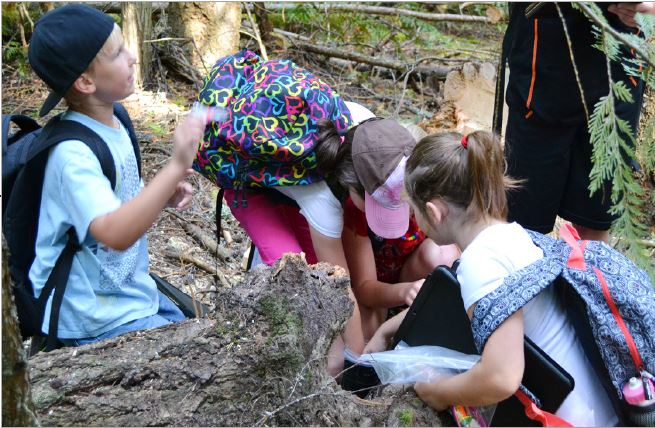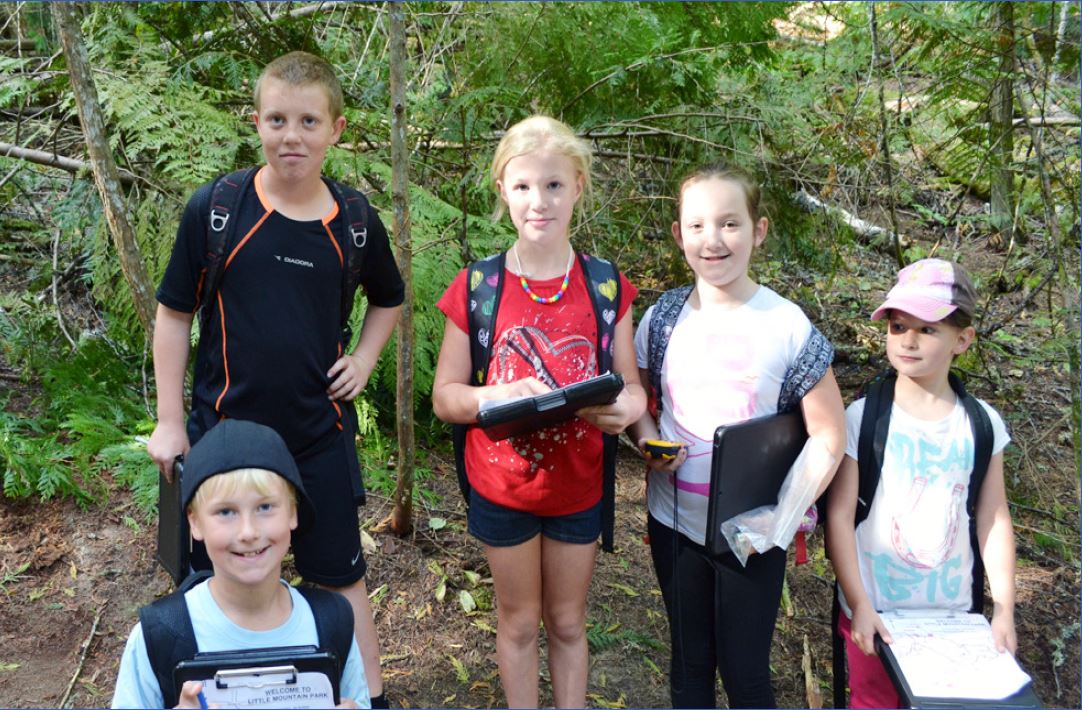Thanks to Alice Hucul of the North Okanagan-Shuswap District for sending us the following story about how local schools are planning to use their CEAF and PCAF grants to support hands-on environmental learning.
This fall, four schools in the North Okanagan-Shuswap District were successful in earning grants from the Habitat Conservation Trust Foundation. M.V. Beattie, South Broadview, Carlin Elementary Middle School and Eagle River Secondary School had their proposals approved for funding. M.V. Beattie’s program received a Public Conservation Assistance Fund (PCAF) grant while the other three received funding from the Conservation Education Assistance Fund (CEAF). The grants are being used by the schools for different activities but have one common theme – all will help expand the classroom to include outdoor learning for students!
 At M.V. Beattie, the $3,200 PCAF grant is helping change a wet “problem area” on the school grounds into a replica of Shuswap River, and will become a place where students can study wetlands. Retired principal and outdoor activist Kim Fulton (aka Dr. Fish) has been helping M.V. Beattie with this project. He explains wetlands are one of the most threatened, undervalued, and misunderstood ecosystems in B.C. By re-creating a wetland system on the playground, classes will study its evolution, and come to know its beauty and ecological benefits. Hopefully, present and future decision makers will be better equipped to make informed choices for fish and wildlife. Principal Denise Brown says that, in future, a solar powered waterfall will be added into the existing wetland. “The movement of the water is important to the environment and the aesthetic value will be appreciated by our students and the community in general. Often the children spend their break times in the wetland exploring and watching nature.”
At M.V. Beattie, the $3,200 PCAF grant is helping change a wet “problem area” on the school grounds into a replica of Shuswap River, and will become a place where students can study wetlands. Retired principal and outdoor activist Kim Fulton (aka Dr. Fish) has been helping M.V. Beattie with this project. He explains wetlands are one of the most threatened, undervalued, and misunderstood ecosystems in B.C. By re-creating a wetland system on the playground, classes will study its evolution, and come to know its beauty and ecological benefits. Hopefully, present and future decision makers will be better equipped to make informed choices for fish and wildlife. Principal Denise Brown says that, in future, a solar powered waterfall will be added into the existing wetland. “The movement of the water is important to the environment and the aesthetic value will be appreciated by our students and the community in general. Often the children spend their break times in the wetland exploring and watching nature.”
A public trail will be constructed to go right past the wetland, allowing the community at large to enjoy and also develop a better understanding and appreciation of the function and beauty of wetlands.
South Broadview Elementary received a $3,500 CEAF grant, which will be used to fund experiential outdoor learning opportunities taking place throughout the school year. Thanks to the grant, the 85 students in Grades 4 & 5 will be travelling to some 25 different sites to enhance their classroom learning. In September, students visited Gorge Creek, where they photo documented the ecosystem and plant and animal interactions, witnessing decomposers in action. They also had to analyze simple food chains and create a presentation. Later in the year, students will visit the Salmon Arm landfill, the sewage treatment plant and the water treatment plant. To learn about the strategies municipalities are implementing to reduce their ecological footprints, students will observe first-hand what is happening to waste and water in their community. The teachers have tied this grant in with the school district’s action research initiative, which gives schools some seed money to do a project which helps develop student engagement in learning. With the addition of the CEAF grant, the school was able to add in some further outdoor learning opportunities including cross country skiing, snowshoeing, biking and a trip to the Kingfisher Interpretive Centre.
Carmen Dawkins’ Grade 4-5 Class at Carlin Elementary Middle School received a $486 CEAF grant which will be used to connect students with local habitats. Dawkins explains her school is starting to explore the local and larger watershed, using the Shuswap Watershed Project as a guide. “We will give students two different field experiences to increase their knowledge of this watershed: one at White Lake, which includes following its outlet to Shuswap Lake, and the other at Adams River, which also flows in to Shuswap Lake but at a different location,” Dawkins says. “First-hand experience under the leadership of knowledgeable adults is a way to build community and further connect our students with local habitats. We will use local professionals who work in the field of biology and individuals who are developing expertise through participation in various local ecology projects or groups. We will travel to two different farm locations to illustrate to students how White Lake flows in to the Shuswap. We will visit the Adams River to expand students’ understanding of how broad the Shuswap Watershed is.”
“Learning about the turtles and the Turtle Study project at White Lake serves to educate students and parents that as a community we can all contribute to the health of our watershed. Having similar field experiences will build community within our student body,” she adds.
Eagle River Secondary in Sicamous received a $1,500 CEAF Grant to offset the transportation costs for various field trip opportunities. Principal Scott Anderson says the grant will allow the school to provide an even richer outdoor experience for students.
“We support a great deal of field trips to support and enhance learning activities in the ‘real world’, but this grant has been critical in increasing the number of trips, the complexity of activities, and the number of students we’re able to accommodate. Without the grant we would not be able to support to nearly this degree.”
“To date we have taken kids to pick vegetables from farms that were then donated to local food banks, participated in shoreline cleanups, science field trips to identify local plants and their traditional First Nations uses, the Encountering Wildlife program at the Kamloops Wildlife Park, local walking trail maintenance and cleanup, GPS mapping/ex-ploring/geocaching of local wilderness areas.”
All those involved would like to thank the Habitat Conservation Trust Foundation and anglers, hunters, trappers and guides who contribute to the Trust, for making a significant financial contribution to support these projects.







